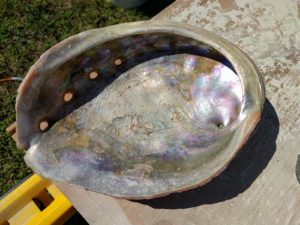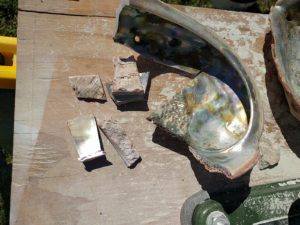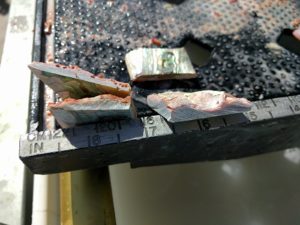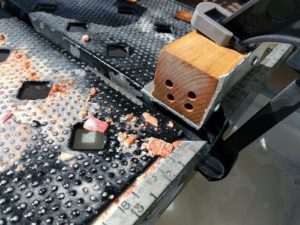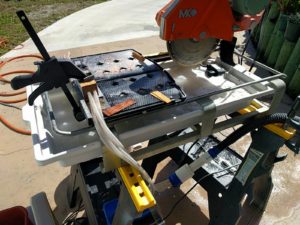I like to do pearl inlay, and I like different types/colors of mother of pearl. One of my favorites is from the California red abalone (Haliotis rufescens). Unfortunately for the species its numbers have been drastically impacted due to historic over-fishing. There is currently no commercial red abalone harvest, and private ‘sport’ harvest is very limited. Because of this there is very little red abalone pearl available, if any at all, from the usual inlay suppliers. This fact, plus the fact that part of me likes to start with the ‘basics’ and work ones way up from there, leads me to cut my own red abalone pearl.
I have, over the years, acquired some abalone shells here and there, yard sales, friends who gave me some, etc. All of this is old shells that have been kicking around for a while, holding incense, being ashtrays, etc. I finally got around to processing these shells. Many of the shells were filled with lots of tiny holes, which are caused by a boring sponge that attacks the abalone. The shells, or portions of shell, that have all these tiny holes are useless for inlay. This means that the ‘yield’ can be pretty low.
One starts with a shell, the bigger, thicker, and flatter in shape the better:
I mark out what I think are the biggest areas that are reasonably flat, and then cut the shell up with a diamond cut-off blade on my angle grinder. Makes a lot of dust. Back yard with a nice breeze at ones back is a must. This gives shell pieces:
Then one flattens the inside, which is concave from the shape of the shell. I have used various methods to do this flattening, but this time I used a small bench-top belt sander with 80 grit paper. Works pretty well but I rotated through pieces multiple times to try and keep the heat build-up to a minimum. Again, lots of dust.
Once things are flattened you have pieces with a nice flat side, but there is lots of the outside of the shell, ‘bark’ if you will, left that must be dealt with.
To cut the pearl down to a nice flat, thin, blank I devised a setup to use on a rented wet diamond tile saw (Home Depot). These diamond tile saws cut granite tile easily, so they cut pearl just fine. Also, since the saw runs with a good water flow over the blade there is no dust and no heat. To hold the pearl as it is being sawn, I made a little piece which has aluminum ledges for the bottom and side, and holes that lead to tubes, that are connected to a wet/dry shop vacuum. This produces good suction against the flat side and holds the piece of pearl nicely while you run it through the saw.
The net result is 22 ounces of red abalone pearl blanks:
The places that still have some red abalone pearl for sale charge $35 – $40 per ounce, so these 22 ounces make it worth renting the tile saw and I can say, when I sell an instrument, that I cut the wood from a tree with a chain saw and I cut the pearl from a shell. I kind of like that notion of starting with the basic materials and ending up with a musical instrument.
